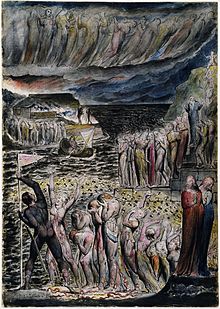| The Vestibule of Hell and the Souls Mustering to Cross the Acheron 1824-27ink and watercolour over pencil (NGV 4) Felton Bequest, 1920 989-3 National Gallery of VictoriaInferno III, 22-83. Dante, led by Virgil, has entered the Vestibule of Hell and reached the shores of the river Acheron where the souls of those who lived without blame and without praise wait to be ferried across; above them mourn the choir of angels who neither rebelled nor were faithful to God, and who were chased from Heaven but refused by Hell. Dante describes the ensign with a banner leading the souls, and the hornets and wasps that attack them. | |
From Wikipedia
Mythology
In ancient Greek mythology, Acheron was known as the river of woe, and was one of the five rivers of the Greek underworld. In the Homeric poems the Acheron was described as a river of Hades, into which Cocytus and Phlegethon both flowed.[2][3]
The Roman poet Virgil called it the principal river of Tartarus, from which the Styx and Cocytus both sprang.[4] The newly dead would be ferried across the Acheron by Charon in order to enter the Underworld.[5]
The Suda describes the river as "a place of healing, not a place of punishment, cleansing and purging the sins of humans."[7]
According to later traditions, Acheron had been a son of Helios and either Gaia or Demeter, who had been turned into the Underworld river bearing his name after he refreshed the Titans with drink during their contest with Zeus. By this myth, Acheron is also the father of Ascalaphus by either Orphne[8] or Gorgyra.[9]
The river called Acheron with the nearby ruins of the Necromanteion is found near Parga on the mainland opposite Corfu. Another branch of Acheron was believed to surface at the Acherusian cape (now Karadeniz Ereğli in Turkey) and was seen by the Argonauts according to Apollonius of Rhodes. Greeks who settled in Italy identified the Acherusian lake into which Acheron flowed with Lake Avernus. Plato in his Phaedoidentified Acheron as the second greatest river in the world, excelled only by Oceanus.
He claimed that Acheron flowed in the opposite direction from Oceanus beneath the earth under desert places. The word is also occasionally used as a synecdoche for Hades itself. Virgil mentions Acheron with the other infernal rivers in his description of the underworld in Book VI of the Aeneid. In Book VII, line 312[10]he gives to Juno the famous saying, flectere si nequeo superos, Acheronta movebo: 'If I cannot bend the will of Heaven, I shall move Hell.' The same words were used by Sigmund Freud as the dedicatory motto for his seminal book The Interpretation of Dreams, figuring Acheron as psychological underworld beneath the conscious mind.
The Acheron was sometimes referred to as a lake or swamp in Greek literature, as in Aristophanes' The Frogs and Euripides' Alcestis.



No comments:
Post a Comment